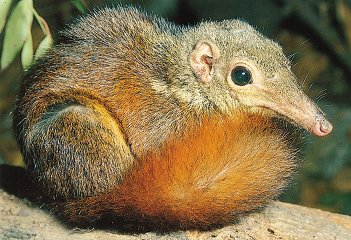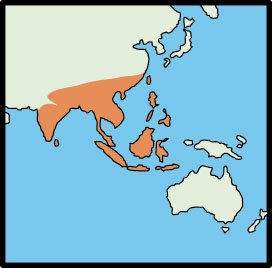THE ORDER SCANDENTIA
Scandentia – Climbing Mammals (19 species.)
The tree shrews, all in one family are placed in an order of their own, Scandentia. They were formerly classed as Insectivores, and some today consider them primates of the suborder Prosimi because of certain internal similarities to the latter. All zoologists are agreed, however, that they are an intermediate between the insectivores and the lower primates, and that they form a link between the two orders, although in appearance they look like pointy-nosed squirrels.

They live in deciduous forests in southern Asia, are both arboreal and terrestrial, and consume both plant and animal matter. The longer snouted shrews tend to spend more time on the ground, probably using their noses to probe for food on the forest floor. Tree shrews tend to pair off in monogamous relationships and live between two and three years of age in the wild. They are somewhat territorial and use strong scent glands to mark that territory. Their main predators are snakes, birds of prey, and small carnivores.
Common tree shrew – TUPAIA GLIS
Possibly Endangered
 Class: Animals with Milk Glands (Mammalia)
Class: Animals with Milk Glands (Mammalia)- Subclass: True Mammals (Eutheria)
- Order: Climbing Mammals (Scandentia)
- Family: Tupaiidae.
The Name “tree shrew”: “Shrew” is a Middle English word for “villain,” which has attached to these animals probably because of their pugnacious manner. They live in trees and are therefore called Scandentia, “climbing” mammals.
Location: Southern China, India, and Southeast Asia.
Habitat: Terrestrial and arboreal. Mountainous forest and shrub areas.
Description: In both appearance and size these animals closely resemble squirrels. Their fur is soft and dense, with colors ranging from gray to green, and either whitish or dark chestnut-brown on the belly. The snout is pointed, the ears small and bare, and the toes are clawed. The big toe is not opposable. The tail is covered with long hair. The tree shrew is about 5.5 to 6″ long, and the tail is about the same. It weighs 3.5 to 7 oz.

Behavior: The common tree shrew’s diet consists of insects, fruit, seeds, and leaves. Like the squirrel, it sits on its hind legs and holds its food with its front feet while eating. It is active during the day and appears to be constantly on the move searching for food. It lives mainly on the ground, building its nest among tree roots or in fallen trunks. Tree shrews live in pairs, with the male marking his territory with a strong-smelling substance secreted from glands situated in the throat.
Reproduction: Gestation requires 46 to 50 days, with the latter usually consisting of two young. Tree shrews become sexually mature at four months of age.
